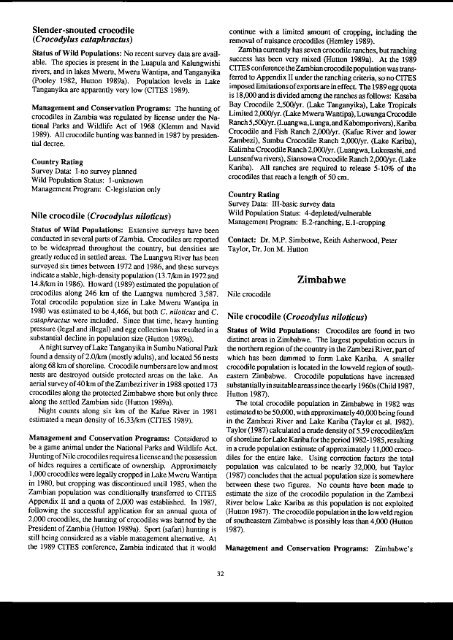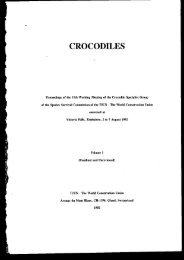size: 7451KB - Crocodile Specialist Group
size: 7451KB - Crocodile Specialist Group
size: 7451KB - Crocodile Specialist Group
Create successful ePaper yourself
Turn your PDF publications into a flip-book with our unique Google optimized e-Paper software.
Slender-snouted crocodile<br />
(C r o c o dy I u s c at a phr ac tu s)<br />
Status of Wild Populations: No recent suvey dala are available.<br />
The spccies is present in lhe Luapula and Kalungwishi<br />
rivers, and in lakes Mweru, Mweru Wantipa, and Tanganyika<br />
(Pooley 1982, Hutton 1989a). Popularion tcvels in take<br />
Tanganyika arc apparendy very low (CITES 1989).<br />
Management and Conservation Programs: The hunrinS of<br />
crocodiles in Zambia was rcgulared by license under rhe National<br />
Parks and Wildlife Acr of 1 8 (Klemm and Navid<br />
1989). All crocodile hunting was banned in 1987 by presidential<br />
decree,<br />
Country Rating<br />
Survey Data: I no suvey planned<br />
Wild Population Starus: l-unknown<br />
Management Prograrn: Clegislarion only<br />
Nile crocodile (Crocodylus nilolicus\<br />
Wild Population Satus: 4depleted/wlnerable<br />
Managcmcnl Program: E.2-ranching. E.l{mpping<br />
Status of Wild Populations: Exlensivc surveys have been<br />
conducted in several parLs of Zambia. Crccodiles arc rcponed Contact: Dr. M.P. Simbotwc, Keirh Ashorwood. Peter<br />
to b€ widcspread throughou{ the counrry, but densiries are Taylor, Dr. Jon M. Hutton<br />
gready reduccd in seltled areas. The Luangwa Rivcr has b€en<br />
surveyed six dmes belween l9?2 and 1986, and dese surveys<br />
indicate a shble, highdensiry populalion ( 13.?/km in 1972 and<br />
14.8,em in 1986). Howard (1989) estimaled l}lc population<br />
Zimbabwe<br />
of<br />
crocodiles along 246 km of the Luangwa numbcrcd 3,587. Nile crccodile<br />
Tolal crocodile populalion <strong>size</strong> in Lake Mwenr Wanripa in<br />
1980 was estimared to bc 4,46r'buittath C. niloticus and C.<br />
catalhrottt s \|erc jnclu.ded. Since that time, heavy hunling<br />
Nile crocodile (Croco dylus niloticus)<br />
pressurc (legal and illcgal) and egg collccrion has resulrcd in a Staaus of Wild Populations: Crccodilos are found in rwo<br />
subslrntial decline inpopulalion <strong>size</strong> (Hu[on 1989a). distincl arcas in Zimbabwe. The largest poputation occu$ in<br />
A night survey ofl-aftc Tanganyika in Sumbu National park the northem region of the country in drc Zambezi River, pan of<br />
found a densily of 2.04m (mostly adulrs), and locatcd 56 nesrs which has b€en damned !o form Lake Kariba. A smaller<br />
along 68 km of shorcline. Crocodilc nunbers are low and most crocodile population is located in $e lowveld region of southsstem<br />
Zimbabwe. <strong>Crocodile</strong> populations ttave increas€d<br />
nests arc destroyed outside protecied arcas on the lalc. An<br />
aerial survey of40 km of lhe Zambezi rivcr in 1988 spotrcd 173<br />
substantially in suilable areas since the early 1960s (Child 1987,<br />
crocodiles along rhe proteclcd Zimbabwe sborc but only thrcc Hu.ton 198D.<br />
along the seldcd Zambian side 0juiton 1989a).<br />
The total crocodile population in Zinbabwe in 1982 was<br />
Nighl counts along six km of thc Kafue River in 1981 esnmalcd ro be 50,000. wi$ approximarely 40,000 being found<br />
cstimatred a mcan density of 16.334m (CITES 1989). in (he Zambezi Rivcr and Lato Kariba (Taylor er al. 1982).<br />
Taylor ( 1987) calculalcd a crude density of 5.59 crocodiles/km<br />
Management and Cons€rvation Programs: Considered io ofshoteline for l-akc Kariba for the pcriod 1982- 1985, resulting<br />
be a game animal under the Nalional Parks and Wildlifo Act. in a crude population esrimate of approximatoly I I,Om croco-<br />
for the enlirc lake. Using conecrion factors $e roral<br />
Hunling of Nilc crocodiles requircsa license and thcpossessiondiles<br />
of hidcs requires a ccnificare of ownership. Appmximatcly popula(ion was calculard lo be nearly 32,000, bur Taylor<br />
I ,000 crocodiles were legally croppcd in kle Mwcru Wantipa (1987) concludes that the actual population <strong>size</strong> is somewh€re<br />
in 1980, bu! cropping was disconrinued undl 1985. when rho between these two figures. No counts have b€on made !o<br />
Zambian population was conditionally rransferred !o CITES eslimalc the <strong>size</strong> of lh€ crocodile population in rhe Zambezi<br />
Appcndix lI and a quora of 2,000 was established. In 1987, River bclow Lake Krriba as this population is nor exploited<br />
following $e successful application for an annual quora of (Hutton 1987). Thc crocodile populalion in rtle lowvetd region<br />
2,000 crocodiles, the hunring of crocodiles was banncd by rhe of soulhcastem Zimbabwc is possibly less than 4,000 (Hutton<br />
Presidenl of Zambia (Hutton 1989a). Spo( (safari) hunring is 1987).<br />
still bcing considered as a viable managemcnt altemarive. A1<br />
the 1989 CITES confercncr. Zambia indicated ftar it woutd<br />
continue with a limited amount of cropping, includiog the<br />
rcmoval of nuisance crocodiles (Hemley 1989).<br />
Zambia currendy has seven crocodile mnches, but ranching<br />
success bas been very mixed (Hufion 1989a). A! the 1989<br />
CITES conference the Zanbian crocodilepopulaUon was tsansfered<br />
to Appendix II under the ranching criteria, so no CITES<br />
impos€d limirations ofcxports are in effecL The 1989 egg quota<br />
is l8,m0andis dividedamong rhetanchesas follows: Krsaba<br />
Bay <strong>Crocodile</strong> 2,5004.r. (Irte Tanganyika), Lake Tmpicals<br />
Limiled 2,000/yr. (kke Mweru'Wantipa), Luwanga <strong>Crocodile</strong><br />
Ran€h 5,50ryF. Guangwa. Lunga, and Kabompo rive6),Ikriba<br />
Crocodil€ and Fish Ranch 2,000 a. (Kafuo River and lower<br />
Zambezi), Sumbu <strong>Crocodile</strong> Ranch 2,000,5,r. (I-ak€ Kariba),<br />
Kalimba <strong>Crocodile</strong> Ranch 2,000/yr. (Luangwa, Lukusashi, and<br />
Lunenfwa rivers), Siansorva <strong>Crocodile</strong> Ranch 2,000/yr. (l-ake<br />
Kariba). All ranches are requircd to release 5-10% of the<br />
cr&odiles that rcach a lenglh of 50 cm.<br />
Country Rsting<br />
Survey Data: trI-basic survey data<br />
Managementand Conservation Programs: Zimbabwe's<br />
32

















